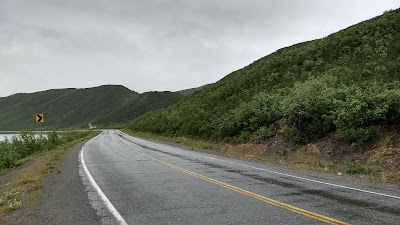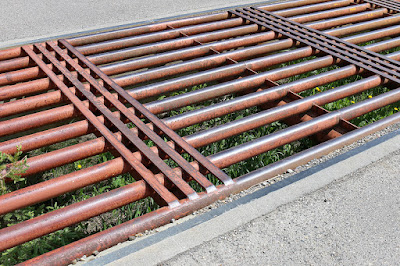I stopped again at the overlook, feeling that something was out of place. I was at around mile 80 (130km) for the day, well past the last water available at the Slana ranger station, and still 45 miles from the finish at the Gakona Lodge. The 5000 meter peak of Mt Sanford was in the distance, the foothills of the Wrangell Volcanic Field wrapped in cloudbursts. On the long climb out of the Slana valley I’d considered packing away the long-sleeved jersey, it was sunnier and warmer than any previous day in Alaska that summer, but still frigid compared to what the rest of the continent was experiencing. I was on the long road between Tok and Gakona, a 200km stretch that during the summers was choked with traffic to and from Canadian border, long lines of cars, RVs and semi trucks.
Nothing. I hadn’t seen a single vehicle, house or person for ages.
It’s difficult to describe something that isn’t there, that defines the space by its absence. Summer Brennan is one of the few who can. She recently wrote, “I went to have a citron pressé down by the river, and saw that two of the big quay trees, poplars that were downed in the recent storms, had been chopped up and stacked, ready for removal. In their place was the bright shock of empty air, a nothing where once a whole moving world had amassed, of shadows and birds and scrambled light. I felt an affinity for that space, where a tree’s branches had swayed for half a century but now were gone. I thought, I am like that air, shimmering with lack.”
The traffic was more or less missing. Like some 28-days later horror movie, the silence was welcome but unnerving, I kept feeling there were cars I wasn’t hearing and I kept looking over my shoulder for no reason, or at least no effect. I was supposed to be good at looking for things that were missing, not just like the Sherlock Holmes story about the dog that wasn't barking, but I've written about the concept of dark reports for national security- tracing what was missing from risk assessments and scientific discussions, tracking down why the data weren't there and what the consequences could be.
I was happy not to fight for room on the road, but the silence just highlighted the pandemic to me, of everything and everyone that had been lost. Everyone was trying to ignore it now, pretend that Covid didn't exist, everything back to normal in the interior with no masks and no distancing (also alarming- most of the people in such regions weren't vaccinated). Except it wasn't the same. Shops and restaurants were closed, time had halted. And only Alaskans were driving.
For a road cyclist, however much we are frustrated with and worried about traffic, it largely defines our experience. Riding bikes in Pristina was a 12-dimensional game of awareness and avoidance, the countryside shifted in summers when the diaspora Schätzi took to the roads in overpowered German cars. When riding on highways we always kept an ear attuned to what was behind us, even during races one looked out for the pace and team cars. But here, on an arterial road, there was nothing. Our one support car had gone ahead to Gakona for the day, I was alone, hours from the finish under a bright sun, three bottles of water left on a single, winding ribbon of asphalt. And with the border still shut from the pandemic, there was little reason for anyone to be in Tok, or trying to get there.
It was difficult to explain to people what we had been doing there, either. On the previous morning three of us had left the Gakona Lodge at 6am in the cold and rain, intent on riding the Richardson Highway north through the Alaska Range to Delta Junction. This ride was one of my goals for the year, perhaps even for two years, having been robbed of most long-distance cycling because of the coronavirus pandemic. 2020 was also notable for lack in that way, as after years of racking up 10,000km years, the longest ride I did last year was 80 miles while never leaving municipal Anchorage. My longing for something more than that, to see more of the state, was obvious in my quest for another bike specifically tailored for endurance rides. The new Domane was a sort of commitment, and the 400km ride to Seward at the start of June was the practice ride. The real goal was the Solstice Ride, 600km over two days, from Gakona to Delta Junction to Tok and back to Gakona, a wild triangle through interior Alaska.
The rain didn’t surprise me, but starting a long ride in such conditions is psychologically tough. The two other riders, Veronica and Martin, also clambered into thermal rain gear, our brevet administrator Tom looking on from the porch. I was dressed mostly in British-designed DHB rain kit, from the merino wool socks to waterproof knee warmers, rain jersey and heavy rain jacket. I had wisely packed some Castelli Oomloop thermal shorts and a Sealskinz cap, but had neglected to bring waterproof gloves and had seriously erred in my shoe inserts. While I had rain booties, the arch supports only went 2/3rds of the way forward in the shoe, leaving several air vents open– my socks would be wet within the first half hour. The bike itself was heavily loaded, with plenty of food that I would be too cold to eat, plenty of water that I would have to force myself to drink, and extra gear, dry clothing, rain jacket, lights, batteries, tools, etc that I hoped I would not need. The clothes and extra gear added close to 20lbs (9kg) to my weight, and made bike handling a bit tricky at times, compared to a ‘clean’ racing configuration.
There was a 6% climb right out of the lodge parking lot, a right turn onto the highway, and then a slow climb toward Paxson. The ride seemed sluggish from the start, as in forcing myself to drink only 5km in my gloves slipped and the bottle went flying off into the ditch. I had to stop and spend several minutes finding it, worried that this was some omen about the challenges of cycling in Alaska– where drinkable water was never easy to find. Then catching up with Veronica and Martin, we had to stop for the first of two construction zones. As with many remote and long construction sites they were using pilot cars, where a flag person would stop us and then we would have to wait for a car to guide us through the zone. Being cyclists, this meant loading the bikes onto the pilot car (usually a pickup) and riding in the cab, which was *not* desirable in the rain. The first section we had to wait 20 minutes, shivering in the cold as all we could do was stand in the wind and rain, and then got into a truck where a woman repeatedly asked us if we’d been dropped on our heads as children. The second section, much longer and more dangerous, I came up first to the woman flagging and told her that there were three of us cycling. She looked at me with the blank stare of Marilyn from Northern Exposure, then got onto the radio.
“This is Control 2, I have three cyclists here.”
She listened to the reply in her headset.
“Yes, on bicycles.”
"..."
“No, I’m not kidding this time.”
A 600km ride, meaning 400km the first day and then another 200 the next, was always a worry for me. As I’ve written before, my TBT injury from decades ago has made sleep deprivation a real risk, and all that I’d read about 600Ks from friends like Betty Jean Jordan suggested that sleep was a scarce resource. I kept calculating in my head how long it might take to get to Tok, what my knee (still strained from the Seward ride) felt like, and where that would leave me the next day. The road between Delta Junction and Tok was nothing too special, it was from Tok to Gakona that needed seeing. So while riding past Fort Greeley into town, I decided it was best to abandon the ride that day, catch a ride with Tom to Tok, and live to ride the next day.
 |
| Alaska pipeline outside Delta Junction |
So there I was past Slana, looking at Mt Sanford on the horizon. Tok to Gakona had been a long and lonely day, often into strong headwinds. Martin and Veronica were already on the road when I left town, and I knew they had a good lead in time and distance. I eventually caught Veronica at mile 100, and we rode into Gakona together the last distance. Martin had somehow gotten lost at Slana (I’m not sure how anyone can get lost on a ride that has literally three right turns) and eventually showed up 30 minutes after us, but having finished the whole 600K.
For me, this was the Alaska I’d wanted to see. Not just the roads without traffic, but cycling gives a different sense of the world, there are details that one would never see from a car or train. It gives a sense of space and distance, of how remote a place is, and what travel must have been more like in past ages. I was away from email and news and all other stress for days, and there was only the road, the bike, the gear, nothing else. One pedal stroke after another, mile after mile, hour after hour, it’s like a deep form of meditation. (Oh, and this time when Prince’s song Raspberry Beret came into my head, I knew the lyrics.) The ultra distance, however, is not entirely my thing. I know I can do 400km in a day, but to ride it alone is not ideal, and after 100 miles I tend to get bored. Perhaps the ultra riders get a different form of dopamine reaction, but for me 100km (especially full gas through Balkan mountains) is the closest I get to euphoria.
Besides, as I wrote three years ago, after finishing the Tour des Stations— what else was there after a race like that?
Oh, the recognition, I suppose. Sitting at the bar that night with Veronica, having a group of Harley and Indian riders compliment us meant something, but apparently I can get that just sticking to Rule #9 (“If you are out riding in bad weather, it means you are a badass. Period.”) Plenty of chances for that in Alaska.


























































